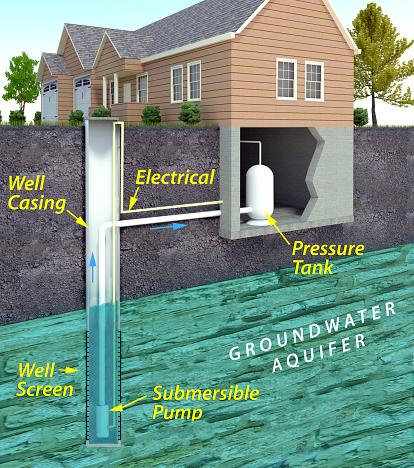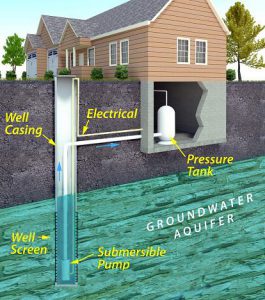
Test your well water at least once a year: Keep your water and your family well
An estimated 2.5 million Floridians (approximately 12% of the population) rely on private wells for home consumption, which includes water for drinking, cooking, bathing, washing, toilet flushing and other needs. While public water systems are regulated by the U.S. Environmental Protection Agency (EPA) to ensure safe drinking water, private wells are not regulated. Private well users are responsible for ensuring the safety of their own drinking water.
The In Florida, pressure tanks are located above ground since basements are not common. The well casing ensures that water is drawn from the desired ground water source – the bottom of the well where the well screen is placed. The screen keeps sediment from getting into the well, and is usually made of perforated or slotted pipe. The well cap on the surface prevents debris and animals from getting into the well. Submersible pumps (shown here) are set inside the well casing and used for deep wells. Jet pumps are used on the surface and can be used for both shallow and deep wells.
How can well users make sure that their water is safe to drink?
It’s important to have well water tested at a certified laboratory at least once a year for contaminants that can cause health problems. According to the Florida Department of Health (FDOH), the most common contaminants in well water in Florida are bacteria and nitrates.
Bacteria: Labs generally test for Total coliform bacteria and fecal coliforms (or E. coli specifically) when a sample is submitted for bacteriological testing. This generally costs about $25 to $30, but can vary depending on where you have your sample analyzed.
Coliform bacteria are a large group of different kinds of bacteria and most species are harmless and will not make you sick. But, a positive test for total coliforms indicate that bacteria are getting into your well water. Coliforms are used as indicator organisms – if coliform bacteria are in your well, other pathogens (bacteria, viruses or protozoans) that cause diseases may also be getting into your well water. It is easier and cheaper to test for total coliforms than a suite of bacteria and other organisms that can cause health problems.
Fecal coliform bacteria are a subgroup of coliform bacteria found in human and other warm-blooded animal feces. E. coli are one species of fecal coliform bacteria. A positive test for fecal coliform bacteria or E. coli indicate that water has been contaminated by human or animal waste.
If your water sample tests positive for only total coliform bacteria or both total coliform and fecal coliform (or E. coli), the Department of Health recommends that your well be disinfected. This is generally done through shock chlorination. You can either hire a well operator in your area to disinfect your well or you can do it yourself. Information for how to shock chlorinate your own well can be found
Nitrates: The U.S. EPA set the Maximum Contaminant Level (MCL) for nitrate in drinking water at 10 miligrams per liter of water (mg/L). Values above this are a concern for infants who are less than 6 months old because high nitrate levels can cause a type of “blue baby syndrome” (methemoglobinemia), where nitrate interferes with the capacity of hemoglobin in the blood to carry oxygen. It is particularly important to test for nitrate if you have a young infant in the home that will be drinking well water or when well water will be used to make formula to feed the infant.
If test results come back above 10 mg/L, never boil nitrate contaminated water as a form of treatment. This will not remove nitrates. Use water from a tested source (bottled water or water from a public supply source) until the problem is addressed.
Nitrates in well water come from fertilizers applied on land surfaces, animal waste and/or human sewage, such as from a septic tank. Have your well inspected by a professional to identify why elevated nitrate levels are is getting into your well water. You can also consider installing a water treatment system, such as reverse osmosis or distillation units to treat the contaminated water. Before having a system installed, make sure you contact your local health department or a water treatment contractor for more information.
Where can you have your well water tested?
Most county health departments accept samples for water testing. You can also submit samples to a certified commercial lab near you. Contact your county health department for information about what to have your water tested for and how to take and submit the sample.
Contact information for county health departments can be found on this site: http://www.floridahealth.gov/programs-and-services/county-health-departments/find-a-county-health-department/index.html
You can search for laboratories near you certified by FDOH here: https://fldeploc.dep.state.fl.us/aams/loc_search.asp This includes county health department labs as well as commercial labs, university labs and others.
You should also have your well water tested at any time when:
- The color, taste or odor of your well water changes or if you suspect that someone became sick after drinking your well water.
- A new well is drilled or if you have had maintenance done on your existing well
- A flood occurred and your well was affected
Remember: Bacteria and nitrate are by no means the only parameters that well water is tested for. Call your local health department to discuss your water and what they recommend you should get the water tested for. The Florida Department of Health (FDOH) also maintains an excellent website with many resources for private well users: http://www.floridahealth.gov/environmental-health/private-well-testing/index.html . This site includes information on potential contaminants and how to maintain your well to ensure the quality of your well water.

